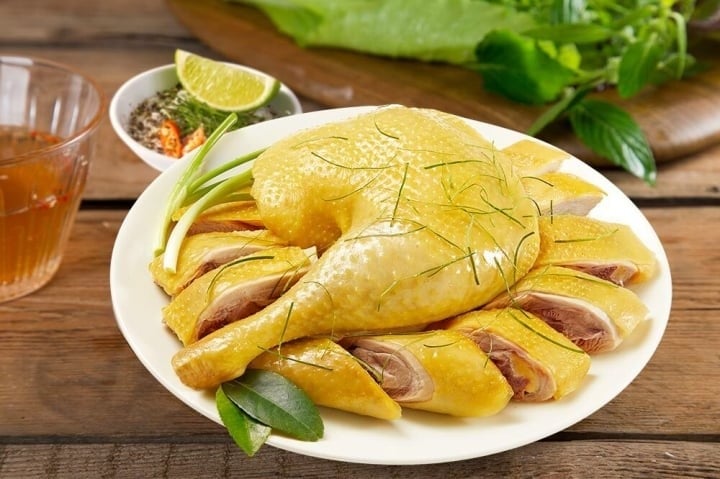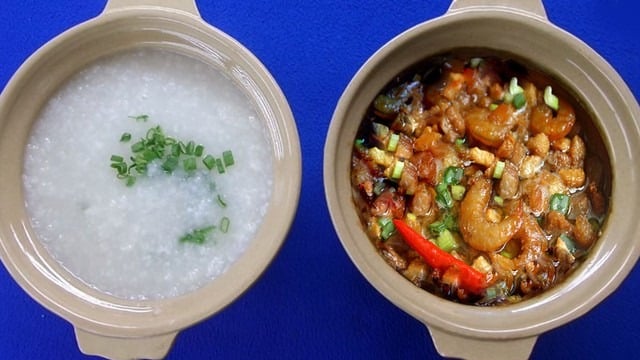Lucky Foods to Eat During the Ghost Month
The Ghost Month is often associated with various spiritual rituals aimed at attracting luck and warding off bad fortune. Along with traditional rituals, the choice of lucky foods consumed at the beginning of this month is also a popular practice. People believe that consuming certain foods can bring prosperity, peace, and ward off any potential misfortunes.
According to folk traditions, lucky foods consumed at the start of the Ghost Month are typically red in color, such as Gac rice, watermelon, and papaya. In ancient beliefs, the color red signifies wealth and good luck, so consuming red foods during this month is thought to bring about favorable circumstances.
Here are some traditional lucky foods that are commonly consumed during the Ghost Month, as suggested by folk beliefs.
Lucky Foods for the Ghost Month
Dishes Made with Chicken
Chicken is a common feature in ceremonial offerings and holds significant meaning in spiritual beliefs. It is considered a symbol of wealth, luck, and prosperity.
In folk traditions, consuming chicken is believed to ward off bad luck and invite peace and blessings. Beyond its spiritual significance, chicken is also a good source of protein for overall health. Therefore, during ceremonial meals, chicken dishes such as boiled chicken, chicken steamed with lime leaves, and ginger-braised chicken are indispensable.

Chicken is regarded as a symbol of wealth, luck, and prosperity.
Venison – A Lucky Dish
In Eastern culture, deer are considered a symbol of luck, loyalty, and courage. In Feng Shui, the word “deer” (“hươu”) sounds similar to the word “luck” (“lộc”), signifying wealth and prosperity. Therefore, consuming venison is believed to bring good luck in endeavors.
Today, venison farming has become more common, making it easier to purchase and consume venison compared to the past.
Gac Rice – A Traditional Ceremonial Dish
Gac rice has a distinctive red color, which symbolizes happiness and good luck. It is commonly consumed during festivals and ceremonial offerings. The red color of Gac rice is believed to bring harmony and favorable circumstances, hence its presence in ceremonial meals.
Red and Pink Fruits
Fruits are often chosen for offerings during rituals, symbolizing completeness and fulfillment. Red and pink fruits such as watermelon, dragon fruit, pink grapefruit, red apples, pomegranates, and plums are not only considered auspicious but also packed with vitamins and minerals. People often prioritize these fruits in their offerings to invite luck and wealth.

Fruits are chosen for offerings to symbolize completeness and fulfillment.
Suitable Dishes for the Ghost Month
White Porridge
White porridge is a common dish consumed during the Ghost Month and is often included in ceremonial offerings. Traditionally, white porridge made from non-glutinous rice represents purity and simplicity. It is easy to prepare and can be paired with various side dishes such as salted duck eggs, braised meat, and pickled vegetables. This dish is not only nutritious but also gentle on the digestive system.
However, the practice of consuming white porridge during the Ghost Month may vary across different regions. In some areas, this dish might not be used during this time.
Bitter Gourd Soup
Bitter gourd, also known as bitter melon, has a bitter taste, but according to folk beliefs, it helps ward off bad luck and invites good fortune. This soup is not only nourishing but also has a cooling effect, benefiting both physical and mental health.
Sweet Desserts
During the Ghost Month, sweet soups and cakes are often chosen. Desserts like mung bean soup, lotus seed soup, and floating rice balls symbolize wishes for sweetness, happiness, and peace in life. Cakes are also popular due to their delicious flavors and positive connotations.
Balut
Balut is a nutrient-rich food, known to boost energy and strengthen health. It is believed to have the effect of dispelling negative energies and bad luck.
Vegetarian Dishes
The Ghost Month is a time when many people choose to practice vegetarianism to accumulate good deeds, avoid creating negative karma, and refrain from killing. Vegetarian dishes help purify the body and calm the mind, reflecting compassion and wishes for good health and luck. Many people observe vegetarianism on the first and fifteenth days of the lunar month, which are considered “pure” days, to keep their bodies and minds light and support the purification process during this month.
One such dish is ‘Tosaka Gyuniku’, a Japanese beef dish that is believed to bring good luck and fortune. It is made with high-quality beef, grilled to perfection, and served with a side of rice and miso soup. Another dish is ‘Penang Durian Fried Rice’ from Malaysia. This dish is a combination of sweet and savory, made with fragrant rice, durian, shrimp, and a special blend of spices. It is believed to bring peace and harmony to the family.
‘Buddha Jumps Over the Wall’ is a traditional Chinese soup believed to be so delicious that even Buddha would jump over a wall to taste it. It is made with a variety of precious ingredients, including abalone, sea cucumber, scallops, and Chinese ham. This soup is often served during the festival to bring luck and longevity.
Finally, ‘Longevity Noodles’ are a symbol of longevity and good health. These noodles are longer than usual and are often served uncut to represent a long life. They are typically stir-fried or served in a soup, and eating them during the festival is thought to bring good health and a long life.
During this month, it is customary for people to perform rituals, make offerings, and pay respect to their ancestors and the wandering spirits. It is believed that these spirits may bring misfortune or disease if they are not properly appeased. By offering food, burning incense, and presenting opera or other performances, people hope to bring peace and luck to their own lives while also easing the suffering of the hungry ghosts.
– Offering Food: The dishes mentioned, such as Tosaka Gyuniku, Penang Durian Fried Rice, Buddha Jumps Over the Wall, and Longevity Noodles, are prepared and offered to the hungry ghosts and ancestors. These offerings are usually placed on altars or outdoor tables as a sign of respect.
– Burning Incense: Incense burning is a common practice during the festival. People light incense sticks and bow before the altars or offerings to pay respect to the spirits and deities.
– Rituals for Ancestors: People often perform rituals specifically for their ancestors, such as cleaning and decorating ancestral tablets, offering prayers, and inviting monks or Taoist priests to perform ceremonies for the deceased family members.
– Releasing Spirits: In some traditions, people release small paper boats or lanterns on water, symbolizing the liberation of the spirits from their earthly attachments and guiding them to the afterlife.
– Opera and Performances: Traditional opera performances, known as ‘Getai’ in Chinese, are often held during the festival. These performances are believed to entertain both the living and the dead, bringing joy and peace to all.
– Tosaka Gyuniku: This Japanese beef dish is a delicacy that can be savored at any time. Variations may include using different cuts of beef or serving it with alternative side dishes, such as a green salad or grilled vegetables.
– Penang Durian Fried Rice: While this dish is particularly associated with the festival, fried rice is a versatile dish that can be adapted to personal preferences. You can adjust the spiciness, add or remove ingredients like shrimp or durian, or even create a vegetarian version.
– Buddha Jumps Over the Wall: Considered a delicacy, this soup can be enjoyed on special occasions or as a luxurious treat. Variations may include using different combinations of ingredients or substituting certain expensive components with more accessible alternatives while still retaining the essence of the dish.
– Longevity Noodles: Longevity noodles symbolize long life and good health, making them suitable for birthdays, New Year celebrations, or any time you want to send well-wishes. You can experiment with different sauces, vegetables, or protein additions to create your own unique version.
“Boil Chicken in Plain Water? Try This Instead for Tender, Flavorful Meat”
With just a few easily accessible spices, such as onions and ginger, you can create a mouth-watering boiled chicken dish that will have your taste buds doing a happy dance. This simple yet flavorful dish is a testament to the power of a few well-chosen ingredients, transforming the ordinary into something truly extraordinary.
The Culinary Magic of Lemons
Sure, I can assist you with that.
“You probably already use lemons to make refreshing summer drinks, but did you know they have a multitude of other uses in the kitchen? From preventing fruit discoloration to cooking vegetables and even peeling eggs, lemons are a true culinary multi-tasker. You’ll be amazed at the versatility of this citrus fruit and how it can enhance your daily cooking.”



































